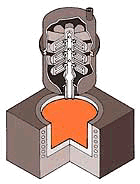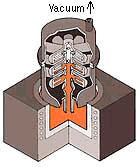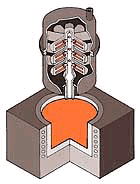View a thumbnail of the cover. The full article is available in Adobe Acrobat (.pdf) format from the Hitchiner Library. |

By capitalizing on the advantages of its unique counter-gravity processes, this investment caster has flourished in the high-volume and thin-wall casting markets.
By Alfred T. Spada, Associate Editor
| Hitchiner Manufacturing Co., Inc. | |
| Milford, New Hampshire | |
| Facilities: | Ferrous Div., Littleton and Milford, New Hampshire; Gas Turbine Div., Milford, New Hampshire; Nonferrous Div., O'Fallon, Missouri; Mexico Div.-Hitchiner S.A. de C.V., Santiago Tianguistenco, Mexico; Tool & Die Div., Amherst, New Hampshire; Metal Casting Technology, Inc., Milford, New Hampshire. |
| Total manufacturing space: | 846,000 sq ft (by the end of 1998). |
|
Casting data: |
aluminum alloys; copper-, cobalt- and nickel-based alloys; ductile, austempered ductile and heat resistant iron; carbon, stainless, and low- and high-alloy steel. |
| 1997 net sales: | $165 million. |
| 1997 shipments: | over 35 million castings. |
| Main markets served: | automotive, aerospace, electronics, firearms, tools and golf. |
|
Castings produced: |
automobile engine roller rocker arms, motorcycle intake manifolds, electronics housings, various jet engine castings, multi-tool jaws, and golf irons and woods. |
|
Processes: |
aluminum and steel die wax pattern injection, investment molding and induction melting. |
|
Value-added capabilities: |
tool- and diemaking, machining, finishing and polishing. |
|
Major customers: |
GM Corp., Chrysler Corp., BMW AG, Pratt & Whitney, General Electric Co. and Callaway Golf Co. |
| Employees: | 3700. |
|
Year founded: |
1946. |
| Staff officials: | John H. Morison, III, president/CEO; Frederick R. Lofgren, executive vice president; G. Dixon Chandley, vice president-technology; Donald J. Buska, vice president and general manager-Mexico Div.; Frederick F. Marston, Jr., vice president-international sales and marketing; Richard L. Sharkey, vice president-corporate engineering; Gregory J. Babich, vice president and general manager-U.S. Ferrous Div.; James E. Pasqualoni, vice president-North American sales and marketing. |
Turning the casting world upside down might be one way of describing Hitchiner Manufacturing Co., Inc., Milford, New Hampshire, during its rise to North America's largest producer of commercial investment castings.
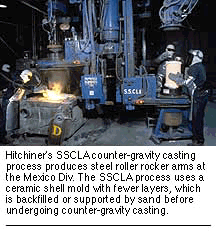 Literally, this family-owned investment caster has
turned the metalcasting process upside down with its unique
counter-gravity casting method that draws the melt up into an
inverted mold via the application of a vacuum. Figuratively,
Hitchiner has taken an upside-down approach to its marketing. By
focusing on the counter-gravity process, this investment caster
has established a niche capability in the high-production and
thin-walled ferrous and nonferrous casting markets.
Literally, this family-owned investment caster has
turned the metalcasting process upside down with its unique
counter-gravity casting method that draws the melt up into an
inverted mold via the application of a vacuum. Figuratively,
Hitchiner has taken an upside-down approach to its marketing. By
focusing on the counter-gravity process, this investment caster
has established a niche capability in the high-production and
thin-walled ferrous and nonferrous casting markets.
In the words of President and CEO John H. Morison III: "We are a unique foundry, not because of what we produce, but because of our process. This process is our advantage, and our success in metalcasting revolves around marketing this process to our customers."
These customers—GM, BMW, Pratt & Whitney, General Electric and Callaway Golf, to name a few—are drawn from different industries, each posing a unique set of requirements. It has been Hitchiner's ability to adapt to these customers and their casting needs, and provide a total casting package—tooling, casting, machining, finishing and polishing—at higher quality levels and lower costs, which has paved the road to success. With a 32% increase in sales since 1995 (from $125 to $165 million), and the production of over 35 million castings last year, this company, which began with a lost wax tradition, believes it now holds the investment casting process for the future.
A Lost Wax Tradition
In 1946, as a member of the War Production Board during World War II, A. Fred Hitchiner saw an opportunity with a 5000-year-old process called lost wax casting. It could provide near net-shape precision parts with specialized alloys that could not be readily shaped by alternative methods. He purchased an eight-employee, solid mold (lost wax) brass foundry in Long Island, New York and relocated it to Manchester, New Hampshire as Hitchiner Manufacturing Co.
Unfortunately for A.F. Hitchiner, the region's industrial base had disappeared to a large extent, and it was suffering from a depressed economy. Luckily, George Abbot Morison and his son John H. Morison (father of the current president) saw the same opportunity in the lost wax process that he had, and bought out the fledgling foundry. With A.F. Hitchiner staying on board to supervise sales and the Morison family in control, Hitchiner began to take shape and moved to its current home in Milford in 1951.
In 1961, the firm became the first investment caster to install a ceramic shell mold building machine, which lowered the cost of mold making versus the traditional solid-mold process. That same year, Hitchiner introduced the world's first mechanized investment casting plant with automated shell-building equipment as well as power- and free-conveyor systems. It also became the first firm to use automated aluminum molds for wax patterns and large induction melting furnaces.
In order to increase market penetration, the father-son team recognized the importance of combining increased productivity with reduced production costs—without ever compromising quality.
Countergravity
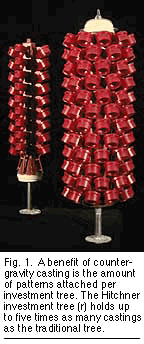 "In 1969, Hitchiner was a family-run company that
again was looking for something different—an
edge," said G. Dixon Chandley, vice president-technology
for Hitchiner. "We needed to find a stable market and
solid customers and knew that if we could remove 40% of
the cost of investment castings, we could approach the
automakers." Up until that point, the investment caster
had focused on firearms, small machine parts and
telephone equipment.
"In 1969, Hitchiner was a family-run company that
again was looking for something different—an
edge," said G. Dixon Chandley, vice president-technology
for Hitchiner. "We needed to find a stable market and
solid customers and knew that if we could remove 40% of
the cost of investment castings, we could approach the
automakers." Up until that point, the investment caster
had focused on firearms, small machine parts and
telephone equipment.
However, removing this cost from a casting was more than just a tweak of the process. According to Chandley, "We needed to do something dramatic."
Chandley's idea that laid the groundwork for Hitchiner's future was to turn the casting process upside down and remove the gating system. By inverting the mold and applying a vacuum to draw the metal up into the mold, the foundry could better control the melt and eliminate the turbulence that traditional gravity pouring created. Because extensive gating wouldn't be needed as turbulence was eliminated, Hitchiner decreased the amount of metal poured per casting.
"The cost of investment castings is in the ceramic, the metal and the cost of melting the metal," said Chandley. "If you get rid of the gating, vacuum-draw the metal into the molds and freeze the castings, the metal in the sprue goes back to the furnace, reducing the metal per casting. In addition, this would allow us to pour more castings per mold and lower the cost of ceramic per sprue."
However, a funny thing happened during the development of this counter-gravity casting process. While testing the soundness of their upside-down castings, the foundry realized that the new process provided additional benefits:
- More Castings per Investment Tree—Once the castings have solidified in the mold, the melt in the sprue flows back to the furnace, thus the castings do not require a cutoff from the sprue. Therefore, Hitchiner is able to assemble more castings per investment tree (Fig. 1), lowering production cost. Depending on casting size and configuration, the pattern population may be up to five times that of the standard investment tree. In addition to this sprue advantage, with certain castings Hitchiner uses its own Tool & Die Div. in Amherst, New Hampshire to produce wax injection molds that form a 360° wax pattern ring to create the sprue. Instead of attaching each casting's pattern one by one to the sprue, Hitchiner interlocks wax rings that contain a whole level of patterns. The lack of cutoff after casting and human hand involvement during assembly allows Hitchiner to inject as many parts per wax ring and cast as many parts per investment tree as a stable shell mold can envelop.
- Cleaner Melt—Since the melt is drawn through the sprue from below the surface with little turbulence, a cleaner melt—free of slag or dross—enters the mold. Comparative tests of ladle-poured and counter-gravity cast steel parts showed that counter-gravity parts exhibited an 85% reduction in non-metallic inclusions. In addition, depending on the alloy, machining tool life increases of 100-500% have been reported.
- Thinner Sections—Due to the full vacuum differential that each level in a counter-gravity investment tree receives, the back air pressure, which is found in the thinner sections of gravity poured castings and causes fluid flow resistance, isn't present. Therefore, the counter-gravity process allows the casting of sections as thin as 0.015 in.
- Grain Structure Control—The counter-gravity process allows Hitchiner to cast at lower melt temperatures (up to 300F lower) than traditional metalcasting, therefore the size and type of grains developed can be widely varied. If the casting requires a fine internal grain structure, a low metal temperature can be used. For aluminum, if the dendritic arm spacing needs to be minimal for better mechanical properties, then low metal and mold temperatures are used for rapid solidification. Table 1 illustrates the high mechanical casting properties the counter-gravity process is able to achieve.

- No Melt Splatter or Turbulence—The mold is filled at a controlled rate, with each level of the investment tree receiving full vacuum differential to fill completely before the level above it starts filling. This discourages the formation of oxides from the splattering of the melt that accompanies traditional gravity pouring.
- Less Metal per Mold—In general, the lack of a sprue or complex gating system allows 60- 94% of the drawn metal to be used to produce the casting. In gravity-poured parts only 15- 50% is typical.
- Lower Machining and Finishing Costs—Once the castings have solidified and the excess melt in the sprue returns to the furnace, the castings are left with gate stubs only 0.25-0.5 in. long. In conjunction with the inherent surface finish advantages of investment casting and the fewer non-metallic inclusions, Hitchiner is left with minimal after-casting costs.
"Our specialization is our process not our product," said Morison. "We maintain a variety of customers and castings. If we don't have a good mix of customers and products, we will be tied to a particular industry and its ups and downs. Our current situation doesn't allow that."
Hitchiner's counter-gravity casting began with the CLA process. Through the years, advancements have been made to adapt the process for vacuum melts and resin-bonded sand molds, however, the basic principles remain the same.
|
||
|
|
|
|
What began in 1964 as a license of Hitchiner's automated shell building technology to Finland's OY Saco AB has developed into the globalization of its counter-gravity casting processes. Hitchiner's licensing of counter-gravity technology differs according to the process. Licensees of the investment casting processes (CLA, CLV, SSCLA, CLI, SSCV and CLIX) receive an exclusive agreement for their territory/market, which leaves the cost open to negotiation. However, licensees of the sand casting processes (CLAS and LSVAC) receive a nonexclusive worldwide agreement for the technology. In addition, these licensees are serviced by CSI Industrial Systems Corp., Grayling, Michigan, which entered into an agreement with Hitchiner to provide equipment and systems to sand casting licensees. The typical cost for the sand casting technology is based upon: a signing fee ($50,000-200,000), the cost of the counter-gravity mold handling and casting equipment ($50,000-1.25 million), and a 4% royalty based on casting sales. This license includes technical support and upgrades to current counter-gravity technology. Once the license has expired, the licensee keeps the technology, but isn't privy to technical support or upgrades. As with any major capital expansion, licensees must adapt their foundries for the new equipment and communicate with Hitchiner to develop counter-gravity systems for their operation. "We take the basic counter-gravity technology and further develop it for the licensee's specific products and foundry," said Stephen Checkoway, director-license administration for Hitchiner. For any of the counter-gravity processes, the only unique equipment required is the counter-gravity mold handling and casting system. For investment casters, standard shell building, autoclaves, burnout ovens and mold cooling systems can be used in conjunction with the counter-gravity systems. For sand casters, any standard resin-bonded molding system and shakeout line can be used. Current North American licensees of Hitchiner's technology include Wescast Industries, Inc., Wingham, Ontario, Hitchcock Industries, Inc., Minneapolis, CWC Castings-Div. of Textron, Inc., Muskegon, Michigan, Alloy Engineering & Casting Co.-a Digitron Co., Champaign, Illinois, and Tallix, Beacon, New York. Following, in order of patent, are the various processes Hitchiner licenses: CLA (1972)—The father of all of Hitchiner's counter-gravity processes, CLA is used for a multitude of ferrous and nonferrous castings such as golf club heads. The process is described in the sidebar "The Steps to Counter-Gravity Casting." CLV (1975)—This is an investment casting process for superalloy parts such as jet engine components that require vacuum-melted alloys. Its process is the same concept as CLA, but the entire melting and casting sequence occurs under vacuum or argon atmosphere. CLAS (1982)—This is Hitchiner's first counter-gravity process for sand casting, and it is used for high volume, ferrous air melt castings such as pipe fittings. A resin-bonded mold is lowered a precise distance into the melt, and a vacuum is applied to draw the metal through numerous pin gates directly to feed the castings. LSVAC (1990)—A derivative of CLAS, LSVAC is a sand casting process for high-volume, complex, air melt castings, such as iron and steel exhaust manifolds. Thin-walled, resin-bonded molds are backed with reusable, loose sand and lowered a precise distance into the melt. Vacuum is applied to the mold to draw the metal up a runner system to feed the castings. SSCLA (1991)—It is the same process as CLA, except the ceramic investment shell is only five layers thick and is backed with reusable loose sand, resulting in lower ceramic costs and no leaker shells. It is applicable to high volume ferrous castings such as auto engine roller rocker arms. CLI (1991)—This is an investment casting process for castings such as missile parts produced in vacuum alloys. CLI uses the same concept as CLA, but the melting is done in a vacuum and the parts are cast under argon atmosphere. Larger shells can be cast, and the cost is lower than CLV. SSCV (1994)—The process is similar to SSCLA, but instead it has a valve at the bottom of the sprue so the melt is held in the sprue, instead of returning to the furnace, to feed larger castings as they solidify. SSCV is a high-production process for larger (up to 450 lb) thick-walled (up to 6 in.) ferrous castings such as aerospace parts. CLIX (1994)—This process is used for reactive alloys such as titanium aluminide. The melt undergoes an exothermic reaction in the furnace before it is drawn up into the investment shell. Hitchiner produces titanium golf woods and titanium-aluminide valves with this process. |
||
Process Specialization
Through the years, Hitchiner has been able to adapt its counter-gravity casting process to an application or a customer. In 1969, the first counter-gravity system was coined CLA for counter-gravity low-pressure air-melt alloys. It is the basis for all other counter-gravity processes. Each adaptation of the original CLA machine (see sidebar "Hitchiner Licenses Counter-Gravity Worldwide"), while providing the casting benefits as outlined previously, also has benefits specific to its purpose. These adaptations are the cornerstone of this investment caster's marketing.
"Anybody can make an investment casting," said James Pasqualoni, vice president-North American sales and marketing. "We have grown in the industry because the specialization of our process allows us to make various types of castings at a better quality and lower cost."
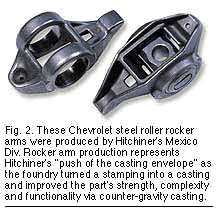 Castings Hitchiner cites as a specialization of its
process are the automobile engine roller rocker arms produced by
the Ferrous Div. in Milford for BMW. In 1994, Hitchiner approached
BMW about the possibility of producing the carbon steel rocker
arms for their M43 and M44 engines. European foundries had been
producing their equivalent to roller rocker arms—roller
finger followers and others—as castings. It is a small,
intricate, thin-walled part, which can't have surface defects and
must be produced in high volumes with visual appeal. Hitchiner saw
the part as an opportunity for its supported shell counter-gravity
process (SSCLA) and became the first U.S. foundry to produce a
rocker arm for an OEM (aftermarket rocker arms are cast).
Castings Hitchiner cites as a specialization of its
process are the automobile engine roller rocker arms produced by
the Ferrous Div. in Milford for BMW. In 1994, Hitchiner approached
BMW about the possibility of producing the carbon steel rocker
arms for their M43 and M44 engines. European foundries had been
producing their equivalent to roller rocker arms—roller
finger followers and others—as castings. It is a small,
intricate, thin-walled part, which can't have surface defects and
must be produced in high volumes with visual appeal. Hitchiner saw
the part as an opportunity for its supported shell counter-gravity
process (SSCLA) and became the first U.S. foundry to produce a
rocker arm for an OEM (aftermarket rocker arms are cast).
The investment caster converted what was previously a stamping and provided two crucial advantages to the casting: stiffness and lubrication flow. As engine efficiency increases, it runs faster and hotter, and the rocker arm must withstand this intense heat and pressure. The cast rocker arm provides a stiffness and strength not available from a stamped version and includes a push-rod socket, among other channels, to allow lubrication flow in the engine. According to Hitchiner, if this part had been cast via traditional investment casting, it would have twice the cost per casting, and, as a result, never would have been converted. However, with the successful casting via counter-gravity, Hitchiner now produces rocker arms daily for BMW and GM (Fig. 2) and is developing a prototype for Chrysler.
The success of its counter-gravity casting processes in-house and with its licensees, as well as its desire to further adapt counter-gravity to sand and lost foam casting, prompted the investment caster to search for an R&D partner in 1986 that would expand its research capabilities beyond its small technical center. The first door Hitchiner knocked on was General Motors Corp., Detroit, Michigan. It also was the last. "GM's interest started out as a potential opportunity for high-alloyed compositions of exhaust manifolds," said Ron Cafferty of GM Powertrain and secretary of MCT's Board of Directors. "These discussions opened our eyes to other opportunities for counter-gravity casting technology. Hitchiner wasn't focused on automotive applications, so it brought to the table different experiences, different ideas and different paradigms." GM and Hitchiner formed a joint venture, Metal Casting Technology, Inc. (MCT), in Milford, New Hampshire, as an R&D center "to generate useful, new, near net-shape casting technology," said MCT President G. Dixon Chandley. Since 1986, it has developed 18 patented processes. The 24,000-sq-ft facility houses 25 engineers and technicians who divide their time between investment casting, automotive/GM and floating research (40%, 40% and 20% respectively). Some of the technological breakthroughs the center has produced include Hitchiner's SSCLA and SSCV processes and an automated system to mechanically assemble ring pattern waxes into a sprue. In 1997, MCT established a prototype production facility for liquid hot isostatic pressing (LHIP). Liquid HIPping uses pressurized hot molten salts instead of the high gas pressure of conventional HIPping to eliminate internal porosity in castings. Replacing the 27,000 psi gas of conventional HIPping with a liquid has made the process safer as well as faster, as a casting can be liquid-HIPped in seconds as opposed to hours. According to Cafferty, this process could eliminate X-ray testing, as castings automatically will be HIPped to a first-rate quality level, skipping the inspection process. Also currently under development at MCT are commercial casting production processes for titanium- and zirconium-based alloys, metal matrix composite parts and the counter-gravity casting of 2-3 mm wall thickness stainless steel exhaust manifolds using the LSVAC counter-gravity loose sand casting process with both shell sand molds and lost foam patterns. |
Process Expansion
With the ramp-up of its new 89,000 sq ft state-of-the-art Automated Casting Facility in Milford this fall, Hitchiner is working toward more casting successes like the rocker arm applications. According to Chandley, automotive applications will continue to provide the investment caster's foundation as the firm estimates that it now produces 95% of all automotive investment castings in the U.S.
Hitchiner believes its success with the casting of stainless steel exhaust manifolds using the loose sand casting counter-gravity process, LSVAC, will pave the way for this part's production in the early part of the next century. In addition, the new supported shell counter-gravity check valve adaptation, the SSCV process, allows Hitchiner and its licensees to pursue markets for larger, one-of-a-kind, name-recognition castings.
"Even though we are a company that has a process
that is 26 years old, we are constantly reinventing ourselves,"
said Morison. "We have a multitude of opportunities in our niche
and are always looking for new applications for our processes and
our capabilities. But, it is up to us to go to our customers and
show them what we can do."
Return to the Hitchiner Home Page.
Last modified and validated 11-August-1998 by
| & | for "AND" |
| | | for "OR" |
| ! | for "NOT" |
| [ ] | to group terms |
